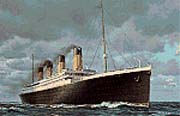The Titanic was a British passenger ship that struck an iceberg and sank in the North Atlantic Ocean in 1912. The disaster ocurred on the liner's maiden voyage, from South Hamptom, England, to New York City. The Titanic side swiped the iceberg at about 11:40 p.m. on April 14.The impact caused a number of small cracks and failed riveted seams in the ship's hull. Seawater flooded through the bow of the ship. About 21/2hours later, the vessal broke in two and sank.
The Titanic carried enough lifeboats for only half of its approximately 2,200 passengers and crew. The first rescue ship to reach the site, the British liner Carpathia, arrived about 4:00a.m. and picked up 705 survivors, most of whom were women and children. A total of 1,517 people died in the disaster. The Titanic's captain, Edward J,Smith, went down with his ship.
 The Titanic was the largest and most luxurious ocean liner of its time. It displaced more than 53,000 metric tons of water and measured 269 metres in length. Many people believed the ship was unsinkable because its hull was divided into 16 watertight compartments. Even if 2 of these compartments flooded, the ship could still float. As a result of the collision with the iceberg, 6 compartments initially flooded.
The Titanic was the largest and most luxurious ocean liner of its time. It displaced more than 53,000 metric tons of water and measured 269 metres in length. Many people believed the ship was unsinkable because its hull was divided into 16 watertight compartments. Even if 2 of these compartments flooded, the ship could still float. As a result of the collision with the iceberg, 6 compartments initially flooded.
In 1985, a team of French and American scientists led by Robert D.Bullard of the United States and Jean-Louis Mechel of France found the wreckage of the Titanic. The ship lay in two sections about 650 kilometres southeast of Newfoundland at a depth of about 3,800 metres.
For years, people thought that the Titanic sank because the iceberg cut a huge gash in its hull. But the wreck showed no sign of a gash. A study of steel samples from the ship concluded that the hull was made of a steel that became brittle in the frigid North Atlantic waters and fractured easily during the collision. Inquiries have also shown that the Titanic was travelling too fast for an area where there are dangers of icebergs.